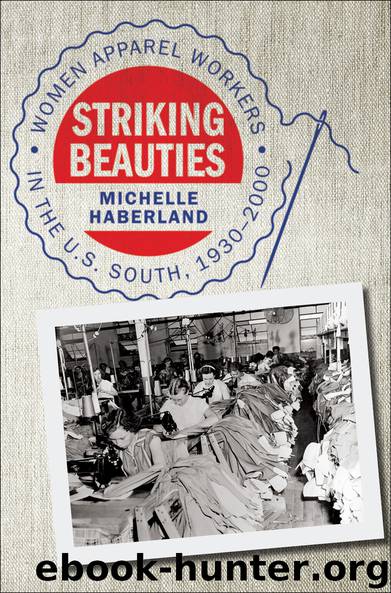Striking Beauties by Haberland Michelle;

Author:Haberland, Michelle;
Language: eng
Format: epub
Publisher: University of Georgia Press
Published: 2015-05-25T04:00:00+00:00
Chapter Five
“LOOK FOR THE UNION LABEL”
ORGANIZING WOMEN WORKERS
AND WOMEN CONSUMERS
In 1975 the International Ladies’ Garment Workers’ Union label became one of the most widely recognized symbols in the history of the American labor movement. Of all the strikes and strategies the U.S. apparel unions have utilized since World War II, none has been as popular or as readily recognized as the ILGWU song and television commercial titled “Look for the Union Label.”1 Created by an innovative advertising team in 1975, the jingle was dubbed “the cry of the American labor movement” and was featured on a host of contemporary television programs. If imitation is the highest form of flattery, then the ILGWU must certainly have been proud when the cast of Saturday Night Live parodied the well-known commercial that featured a diverse group of mostly women members of the ILGWU sending a message of solidarity by singing in unison. Although the commercial itself was aired only sixty times between 1978 and 1985, it did much to increase awareness of the union label and to encourage consumers to consider the workers who made their clothing.2
A few years before the ILGWU launched its “Look for the Union Label” advertising campaign, the Amalgamated Clothing Workers of America initiated a boycott against Farah Manufacturing, a leader in the production of men’s apparel, located in El Paso, Texas. Like the ILGWU, the ACWA relied on a national campaign that encouraged consumers to boycott Farah products until Willie Farah recognized the right of the largely Latina workforce to be represented by the union. In both the Farah boycott and the ILGWU label campaign, the moral and political dimensions of consumption and purchasing power were paramount. In addition, both apparel unions used the boycott strategy to advance their organizing efforts in the South, where many runaway, nonunion companies had relocated decades earlier. The role of women as the primary consumers of the household placed them in a critical position to determine the success or failure of the unions’ campaigns. These two important consumer actions did not, of course, spontaneously develop in the 1970s. Rather, both the ILGWU and the ACWA drew on a long history of organized consumer actions both within and beyond the clothing industry itself. The history of this type of consumer protest provides a context for the Farah boycott and the ILGWU’s “Look for the Union Label” campaign.
Although boycotts and label campaigns occupy opposite ends of the consumption spectrum, they both seek to control consumption in an effort to shape politics and policy. The boycott prohibits consumption of particular goods or services, while the union label strategy encourages consumption. Throughout the course of U.S. history, the boycott has proven to be one of the most effective and popular consumer actions. Typically, boycotts have taken one of three primary forms. A standard boycott encourages consumers to stop doing business with a single company whose behavior or politics are objectionable. The label is another common but more complicated strategy related to the boycott. The company affixes a label to its product to indicate compliance with a specific standard of production.
Download
This site does not store any files on its server. We only index and link to content provided by other sites. Please contact the content providers to delete copyright contents if any and email us, we'll remove relevant links or contents immediately.
| Civilization & Culture | Expeditions & Discoveries |
| Jewish | Maritime History & Piracy |
| Religious | Slavery & Emancipation |
| Women in History |
Cecilia; Or, Memoirs of an Heiress — Volume 1 by Fanny Burney(32060)
Cecilia; Or, Memoirs of an Heiress — Volume 3 by Fanny Burney(31455)
Cecilia; Or, Memoirs of an Heiress — Volume 2 by Fanny Burney(31406)
The Secret History by Donna Tartt(18158)
Sapiens: A Brief History of Humankind by Yuval Noah Harari(13986)
Leonardo da Vinci by Walter Isaacson(12800)
The Radium Girls by Kate Moore(11621)
Sapiens by Yuval Noah Harari(5122)
How Democracies Die by Steven Levitsky & Daniel Ziblatt(4954)
The Wind in My Hair by Masih Alinejad(4839)
Homo Deus: A Brief History of Tomorrow by Yuval Noah Harari(4687)
Endurance: Shackleton's Incredible Voyage by Alfred Lansing(4503)
The Silk Roads by Peter Frankopan(4271)
Man's Search for Meaning by Viktor Frankl(4269)
Millionaire: The Philanderer, Gambler, and Duelist Who Invented Modern Finance by Janet Gleeson(4094)
The Rape of Nanking by Iris Chang(4022)
Hitler in Los Angeles by Steven J. Ross(3798)
The Motorcycle Diaries by Ernesto Che Guevara(3784)
Joan of Arc by Mary Gordon(3782)
